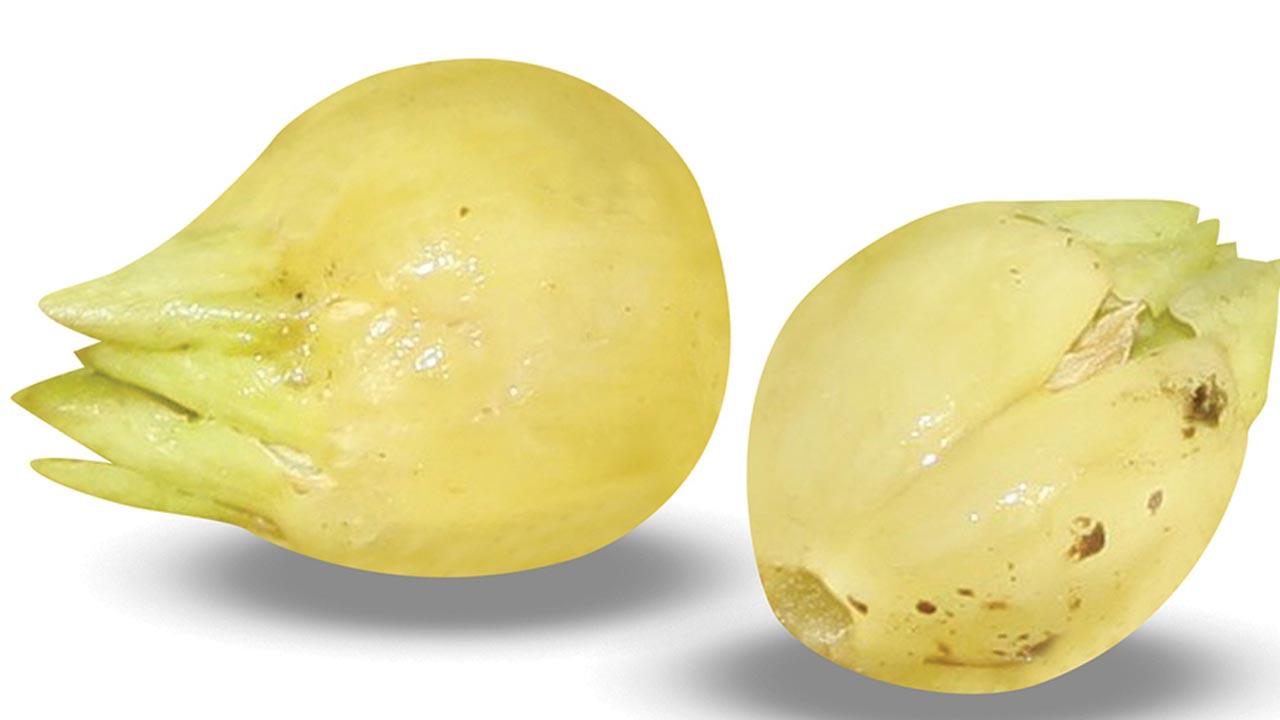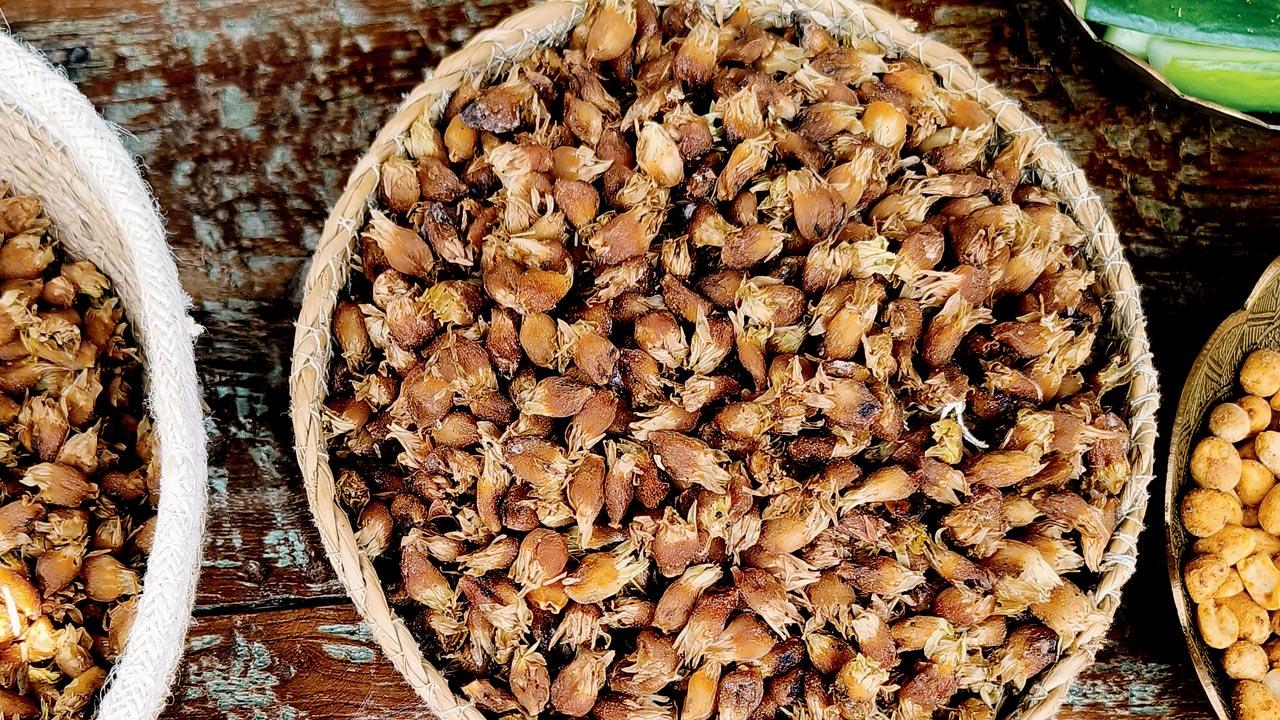In Dahanu, a mahura tree stood in full bloom—its namesake flower at peak harvest, fuelling the revival of India’s heritage spirit

Fresh mahura flowers offer a grape-like texture with a floral, grassy note. Pics\Phorum Pandya
A bottled cocktail of mahura (also called mahua) mingled in flavours of peach and coconut milk in one hand, we place the other on the bark of a full-blossomed Madhuca Longifolia (mahura tree), known to be the wishing tree, bestowing good health, abundance and prosperity. We take a sip and make a wish, as guided by the team from South Seas Distillery, who launched Six Brothers Mahura last year.
ADVERTISEMENT
We look up into the green branches, the sun shining through the leaves. Clusters of mahura buds droop down. Most had fallen to the ground the night before and had been collected in baskets. Their floral fragrance hangs in the air.

We’re at the mahura tree forest in Dahanu, close to where the present-day distillery is nestled. Today, mahura is consumed in Maharashtra, Gujarat, Madhya Pradesh, Uttar Pradesh, Chhattisgarh, and Odisha, and it is the only spirit distilled from a flower.
We nip the top part of the fresh flowers and bite into it. It has the texture of grape but the sweet comfort of a floral, grassy flavour. The dried red flowers have fermented and sweetened further to give an apricot and date-like taste.

Six Brothers Mahura gets its name from the six founding brothers—Khurshedji, Faramroze, Rustomji, Kuvarji, Nanabhoy, and Jehangirji. In 1922, the Maharaja of Jawhar and the Maharaja of Akkalkot invited them to set up distilleries in their princely states. Production stopped during colonial rule and restarted in Dahanu in the 1970s.
Chef Mukhtar Qureshi of Waarsa at NCPA has planned a four-course Awadhi lunch. Each course is paired with a mahura drink. We soak in the summer vibe and pick on starters being passed around before we settle under the shade of a mango tree where a modern rustic setting has been arranged.
 Dried mahura flowers take on a rich, apricot-and-date-like sweetness
Dried mahura flowers take on a rich, apricot-and-date-like sweetness
A cocktail of mahura and passion fruit makes for a perfect summer pick, while another with jamun balances the astringent tartness. We bite into ker sangri ki galouti, juicy ananas ka tikka, Hyderabadi prawns and Nizami gosht tikka. Chef Qureshi planned well, and our first course was a sabz santra ka shorba, a desi, chilled gazpacho to beat the heat. In the second course, a mahura shikanji complements a kache kele ki kofta curry served with a decadent Kabul ki dal and freshly baked bakumas bread.
A jackfruit (kathal) biryani, fragrant and earthy with the addition of gucchi, is washed down with KoMa. Prinkesh Singh, bar manager, at Waarsa, explains that the drink has a kokum reduction and blackberry syrup as a sweetener. The mahura comes forward in a bold punch.
 Copper pot stills at the South Seas distillery, Dahanu
Copper pot stills at the South Seas distillery, Dahanu
We end the meal with a neat tasting of chilled mahura, which has a smooth floral, herby and spicy finish of peppers but doesn’t leave a burn. Chef Qureshi brings out the dessert, a rassawal muzzafar and angoori rabdi to balance the shot. “This is a seasonal fruit dessert of the royal gharanas made using Gobindo rice and jaggery,” tells us.
Scotch whiskey is local to Scotland and Ireland; tequila is local to Olmec tribes in Mexico; Rupi Chinoy, Director of South Seas Distilleries, tells us in an interview later that it is time we GI tag it for the country. “If you look at any origin of any spirit in the world, it all began as a community drink. Production of all spirits stopped during the prohibition era. Colonial rulers termed any native Indian spirit as ‘country liquor’,” Chinoy explains.
At South Seas Distilleries, the mahura goes through the same process of fermentation of the flowers and then double distillation in copper pot stills just as luxury Indian single malts. “The process is similar to the production of a single malt except that the raw material here is the dried mahura flowers. Once the flowers are collected, the flowers are dried and then soaked in warm water and left to ferment,” says Chinoy. The flowers change colour in each stage, the dried form taking a deep red hue, The spirit is double distilled in copper pots and then passed through platinum filtration to give it a crisper finish.
After the first distillation, the clean spirit, called hearts, is collected in a vessel. The heads or residue, as known in whisky parlance, is discarded. In the second distillation, the tails or remaining residue, is also discarded. “Compared to whisky, which takes 25 days, distilling mahura takes up to 43 days. Traditionally, mahura is made in homes using distilled pots over embers. “Anything you distil at home will be very different from what you distil commercially. Home brews would be milky and cuts are not controlled,” says Chinoy.
 Subscribe today by clicking the link and stay updated with the latest news!" Click here!
Subscribe today by clicking the link and stay updated with the latest news!" Click here!







